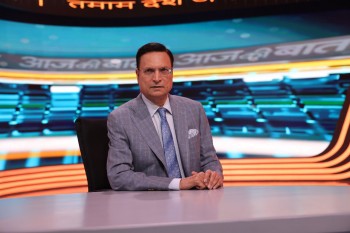 National Security Adviser Ajit Doval reached Moscow on Tuesday to hold talks on strategic partnership, defence, and security cooperation between India and Russia. He is expected to call on Russian President Vladimir Putin.
National Security Adviser Ajit Doval reached Moscow on Tuesday to hold talks on strategic partnership, defence, and security cooperation between India and Russia. He is expected to call on Russian President Vladimir Putin.
Hours earlier, US President Donald Trump threatened to impose additional tariff on India for buying Russian oil. In an interview to CNBC, US President Trump said, “India has not been a good trading partner, because they do a lot of business with us, but we don’t do business with them. So we settled on 25% (tariff), but I think I’m going to raise that very substantially over the next 24 hours, because they’re buying Russian oil. They’re fuelling the war machine. And if they’re going to do that, then I’m not going to be happy.”
Trump also accused India of making profits from Russian oil by selling it to other countries. Reacting to this, Indian External Affairs Ministry in an official statement said, India’s imports are “a necessity compelled by the global market situation”. The ministry said, nations criticising this are themselves “indulging in trade with Russia” even when “such trade is not even a vital compulsion…. Europe-Russia trade includes not just energy, but also fertilisers, mining products, chemicals, iron and steel and machinery and transport equipment,” the official statement said.
Former US Ambassador to the United Nations Nikki Haley has delivered a sharp warning to Trump cautioning that the move to impose high tariffs on India could strain India-US relationship at a crucial time. She warned Trump not to give a pass to “adversary” China and “burn” relations with an ally like India.
Nikki Haley is a senior Republican leader. In the 2024 Republican presidential primaries, she came in second after Donald Trump. In a rejoinder to Trump, Nikki Haley asked why his administration has given a 90-day pause in tariff to China, which is the No.1 buyer of oil from Russia and Iran?
Nikki Haley’s advice seems to be quite interesting. Trump is a trader. For him, relationships or friendships do not matter. Elon Musk is a shining example of this. During the US presidential elections, Musk helped Trump win the polls by extending monetary support, joined his campaign and promoted Trump in the US media.
On a minor issue, he had a spat with Trump, and the US President threatened to send him back to South Africa. Trump went to the extent of threatening to destroy his Tesla group by imposing heavy taxes. This is typically Trump’s style of business.
For him, any country not ready to do trade or lower tariff, bowing to his demands, will be subjected to allegations and threats. Also, if any country sticks to its stand nonchalantly, Trump can also acquiesce. This is how a cunning trader works.
The reason behind flash floods in Uttarakhand
With the NDRF, ITBP, Army, Air Force and BRO rescue teams working in full swing, more than 190 people have been rescued so far from Dharali, located at 8,600 feet above sea level near Uttarkashi.
Uttarakhand chief minister Pushkar Singh Dhami reached Dharali, near Harshil, on Wednesday to oversee relief work. A sudden cloudburst on Tuesday wrought havoc washing away an entire village destroying dozens of houses, hotels and shops.
Official sources put the death toll at 10 and this figure may rise with dozens feared washed away by Kheer Ganga river. Search is going on with the help of IAF Chinook choppers and Prime Minister Narendra Modi in Delhi is personally monitoring the rescue and relief operations.
Dharali village is a tourist spot located between Gangotri and Harshil. The Kheerganga river emerges from Sapta Taal, 3 km away from Harshil. At least five hotels and dozens of houses have been washed away in the flash flood.
Climate expert Soumya Dutta recalled that Dharali village was washed away during the 2013 Kedarnath flash flood tragedy. Geologist Naresh Pant described cloudburst as a natural phenomenon, but it wreaks havoc because of the growth of habitations on riverbanks.
The frightening images of Dharali clearly show the helplessness of humans in the face of nature’s fury. In a matter of 30 seconds, Dharali, a thriving village full of tourists, was converted into a home of the dead. This natural disaster has forced scientists to study why there has been a spate of cloudburst in Himalayan region in recent years.
Cloudbursts have been reported in places like Shimla, Manali, Kullu and Mandi of Himachal Pradesh too. The number of cloudbursts in July this year is almost double compared to cloudbursts in the last five years. Home Minister Amit Shah had set up a committee of geologists from four institutes last week to study the reasons behind frequent cloudbursts in the Himalayan region. This committee is expected to give its report within a week.
Unfortunately, this disaster happened before the report was submitted. In 2013, when Kedarnath tragedy took place, and homes and hotels were washed away like cards in flash flood, the government had then announced that no construction will be allowed near rivers in Himalayan region. But unplanned constructions continued. Secondly, global warming has led to frequent incidents of cloudbursts.
In the Himalayan region, glaciers are melting at a fast rate and glacial lakes are forming. The Central Water Commission report has identified 67 such glacial lakes whose surface areas have increased by more than 40 per cent. Uttarakhand, Himachal Pradesh, Ladakh, Sikkim and Arunachal Pradesh are bearing the brunt of such disasters. Neighbouring areas in Bhutan, Nepal and China also face the same risks from glacier lake outburst floods. All these countries will have to sit together to prepare a joint strategy to deal with natural calamities.